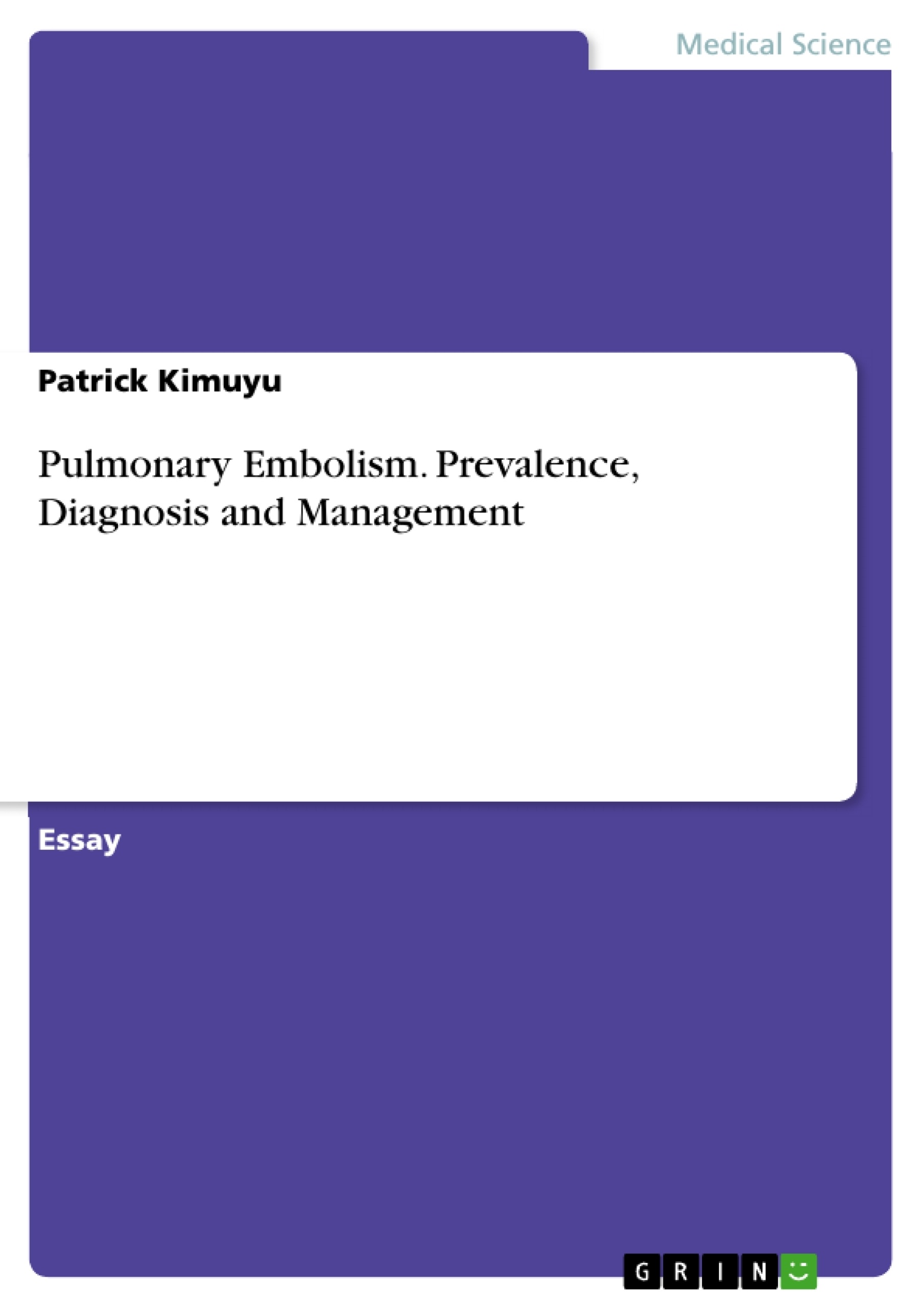Pulmonary embolism is usually a life-threatening condition that occurs due to blockage of the main artery carrying blood to the lungs. This blockage is caused by a blood clot that is carried in the bloodstream to the lung, primarily from the leg following deep vein thrombosis. From a primary care perspective, pulmonary embolism is not considered as a disease with its etiology. Rather, it arises as a complication of a number of conditions that cause venous thrombosis such as deep vein thrombosis, pregnancy and postoperative complications. This literature review focuses on evaluating current evidence based guidelines for diagnosis and management of pulmonary embolism.
Introduction
Pulmonary embolism is usually a life-threatening condition that occurs due to blockage of the main artery carrying blood to the lungs. This blockage is caused by a blood clot that is carried in the bloodstream to the lung, primarily from the leg following deep vein thrombosis. From a primary care perspective, pulmonary embolism is not considered as a disease with its etiology. Rather, it arises as a complication of a number of conditions that cause venous thrombosis such as deep vein thrombosis, pregnancy and postoperative complications (Ouellette, 2015). This literature review focuses on evaluating current evidence based guidelines for diagnosis and management of pulmonary embolism.
Incidence and Prevalence
Epidemiological trends of pulmonary embolism vary from country to country and among different populations. In the United States, pulmonary embolism has become a public health problem due to its high prevalence and incidence. Currently, about 250,000 new cases of pulmonary embolism occur annually. This accounts for an incidence of 1 person per every 1000 people in the US. Clinical data indicate that pulmonary embolism accounts for 200,000 deaths, annually. Three decades ago, the prevalence of the disease was 6%, but clinical interventions and improved diagnosis has lowered it to 2% (Abbas & Mitchell, 2010).
Pathophysiology
From the nursing perspective, the physiology of pulmonary embolism can be explained through its main physiological consequences in the body. Ordinarily, pulmonary embolism is associated with hemodynamic and respiratory consequences. Regarding respiratory consequences, this condition caused death of alveoli leading to hyperventilation and hypoxemia. The principle mechanism of hypoxemia is attributable to reduced cardiac output, ventilation-perfusion mismatch, intracardiac shunt, primarily through foreman ovale, and intrapulmonary shunts. On the other hand, hemodynamic consequences are attributable to pulmonary vascular resistance that is caused by the decrease of pulmonary vascular bed. This resistance increases afterloads in the right ventricle and this might cause ventricular failure. It also involves pulmonary arterial constriction due to reflex and humoral mechanisms (Ouellette, 2015).
Clinical Implications of Pulmonary Embolism
In practice, pulmonary embolism has significant clinical implications. Foremost, the disease exhibits difficulties in diagnosis and its signs and symptoms are similar to those presented by other conditions such as chronic heart failure and COPD. On the other hand, it is a life-threatening condition that causes damage to the lungs and other vital organs. In most cases, failure to provide early clinical interventions leads to lung damage. This may cause pulmonary hypertension and failure of vital organs including the heart due to lack of oxygen supply. Therefore, it is apparent that pulmonary embolism requires appropriate clinical interventions, in order to minimize its related fatalities and morbidity.
Clinical Evidence-based Guidelines
In the past, most cases of pulmonary embolism were hardly noticed due to misdiagnosis. However, this challenge has been solved through the development of appropriate clinical evidence-based guidelines to aid diagnosis. In practice, probability testing guidelines and the rule-out criteria has become the mainstay in diagnosis of pulmonary embolism. The Wells Score and the Geneva Score are used to predict clinical probability, whereas the PERC (pulmonary embolism rule-out criteria) applies in the ruling out the risk of pulmonary embolism.
Wells Score clinical probability is based on suspected cases of deep vein thrombosis or its history, tachycardia, malignancy, hemoptysis, and immobilization. Based on Wells Score, a score of higher than 6.0 (59%) is considered as high probability, 2.0 to 6.0 (29%) is moderate, whereas less than 2.0 (15%) indicates low probability. Alternatively, a score greater than 4.0 indicates likelihood of pulmonary embolism so imaging is considered, whereas a score less than 4.0 indicates its unlikelihood, thus requiring D-dimer test for rule out. On the other hand, diagnostic testing that shows SaO2 of less than 95% indicates low risk of pulmonary embolism, whereas any percentage above 95% is considered a high risk category.
Diagnostic Tests
Currently, there are several diagnostic tests for pulmonary embolism. The main tests include blood tests, imaging, electrocardiogram (ECG), and echocardiography. Blood tests are meant to identify any abnormality in the levels of various blood components or abnormal organ functions. The most commonly used blood tests are D-dimer, full blood count, blood coagulation tests (TT, PT and aPTT), liver enzymes test (LFT), renal function test, electrolytes test, and erythrocyte sedimentation rate (ESR).
D-dimer is considered as the primary test in patients with low and moderate probability of pulmonary embolism. A negative D-dimer test, in which results are based on the cut-off of 500ug/L, indicates the absence of pulmonary embolism (Schouten et al., 2013). However, suspicion of pulmonary embolism requires the other secondary blood tests.
[...]
- Arbeit zitieren
- Patrick Kimuyu (Autor:in), 2017, Pulmonary Embolism. Prevalence, Diagnosis and Management, München, GRIN Verlag, https://www.grin.com/document/384976
-

-

-

-
Laden Sie Ihre eigenen Arbeiten hoch! Geld verdienen und iPhone X gewinnen. -

-
Laden Sie Ihre eigenen Arbeiten hoch! Geld verdienen und iPhone X gewinnen. -

-
Laden Sie Ihre eigenen Arbeiten hoch! Geld verdienen und iPhone X gewinnen. -

-
Laden Sie Ihre eigenen Arbeiten hoch! Geld verdienen und iPhone X gewinnen. -

-
Laden Sie Ihre eigenen Arbeiten hoch! Geld verdienen und iPhone X gewinnen.

